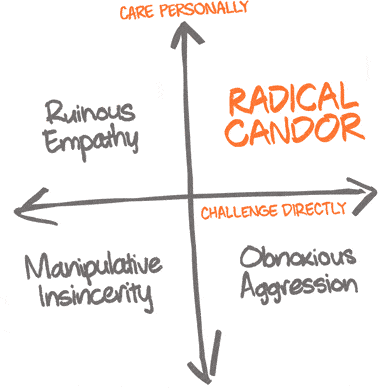When the two choices are to evolve or get eaten, evolution seems like the obvious choice to make. It is really the only option to optimize success as a species, so why don’t we have the same mentality towards adaptation as employees? Feedback is the signal to adapt in your role as an employee to meet the needs of an ever changing environment. Most people shy away from feedback in fear or shame, but without it, we become stagnant in our roles and risk losing our jobs completely. That is why it is a leader’s job to create a culture that embraces hard conversations and to inspire their employees to seek constant learning and improvement through feedback. Radical Candor by Kim Scott, CEO coach and co-founder of Radical Candor, highlights the need to care personally while speaking honestly as a manager.
Scott ranks managers on two dimensions: caring personally and challenging directly. Whereas the sweet spot is high on both and labeled “radically candid,” the three other quadrants are defined as “ruinous empathy,” “obnoxious aggression,” and “manipulative insincerity.” All three demonstrate failure as a boss to appropriately manage and develop their team and talent.
Radical candor is the quality of successful relationships with employees that enables effective motivation and development. Those relationships create the foundation for team efficiency and achievement, and using feedback as a tool for adaptation and learning ensures the sustainability of that success in a steadily advancing context.
Given the advantage of using radical candor as a tool for developing teams and direct reports, many leaders invest in coaching as a delivery mechanism. Even without a formal coaching engagement though, there are plenty of practices that can be implemented every day to build confidence and improve a feedback culture. We recommend starting with the following:
-
Have meaningful, personal conversations with your employees.
Have one on one conversations with your employees about their personal lives, their career aspirations, and some action plans to make it happen. This will help employees feel comfortable around you and recognize your genuine care for them. You will see what motivates them to work most effectively, how to encourage them to develop in their roles, and why their work might be affected by external factors that you don’t normally get to see.
-
Actively listen and engage.
Meaningful conversations mean very little if you don’t pay attention. Truly caring means actively listening. Taking notes and asking questions to facilitate disclosure will foster a better sense of community and increase communication and help you follow up on key points.
-
Give feedback immediately.
There is a mentality to let feedback build until there is a whole laundry list to dump on someone, but it is neither kind nor effective. This method will overwhelm the receiver and they will struggle to improve even one area. Giving feedback immediately will mitigate the risk of forgetting important details of the triggering event and the sense of diminished relevance. However, there are certain situations where having some time to reflect and organize your thoughts may be more appropriate. If you are struggling with the decision to wait or dive right in, this Harvard Business Review article may be of help.
-
Give praise, too.
This is not the same as the infamous ‘feedback sandwich,’ a classic example of ruinous empathy. When someone accomplishes something remarkable, tell them and do it publicly. Avoid giving generic sticker-worthy praise like ‘great job’ or ‘awesome work.’ Tell the receiver precisely what they did well and where you would like them to carry that strength into other projects. Feedback should guide people on what to do going forward more so than only telling them what not to do. Giving praise also makes you look like a more competent leader by recognizing the good work that is being done rather than only the flaws.
-
Focus on the actionable points.
Giving feedback and praise should not be about fixed, unchangeable things or about personality. Feedback should highlight actionable items that can be repeated or changed. Feedback that focuses on personality traits, like telling someone they’re an idiot or something was genius, is not actionable. Inactionable criticism is obnoxious aggression. Similarly, nonspecific praise is ruinously empathetic and can come off as patronizing or pandering. Give praise that encourages others to learn from what was great about a project or criticism that inspires the person to change something in the future, and explain the why you highlighted those aspects.
-
Give feedback in person.
Emailing feedback is the worst, Skyping is better, and in-person is the best. It may feel like the kindest option to spare the receiver the embarrassment, but in-person conversations allow you to assess body language and comprehension. Having an open and confident stance and avoiding scowling or crossed arms will demonstrate positivity and present your feedback as an opportunity for growth. Giving feedback in person will also help reduce miscommunication or misunderstanding and help give the receiver an opportunity to ask questions.
-
Don’t avoid emotion.
Similar to number six, read body language and recognize the other person’s reaction. Feedback can elicit an emotional response, and respect and empathy are critical parts of caring personally. Avoid phrases like “don’t take it personally.” People are entitled to their feelings. Be willing to give them a moment to compose themselves if need be, but always follow up on the conversation!
-
Ask questions and ask for questions.
Always encourage inquiry, and especially when receiving feedback. Questions are the key to clear communication and getting the most out of collaboration. Give ample quiet time to let the person think and respond to the information and think of questions. If they can’t think of any, prompt them with open ended questions to gauge their understanding and how they plan to execute on the feedback.
-
Create a culture of feedback.
A boss should not be the only person responsible for noticing room for improvement and acting on it. Making feedback a priority for everyone will make the exchange more natural and frequent. Start creating a culture of feedback by asking for feedback yourself and making it public. Prove to your direct reports that you can handle being on the receiving end before expecting the same from them. Provide them with the appropriate language and guidelines for giving productive feedback by introducing them to the radical candor scale.
-
Always follow up.
Follow-ups are critical to creating sustainable change on an individual and company wide scale. Do not start strong one week to just fall back into old habits the next. By scheduling recurring meetings and check-ins with your peers and direct reports, you maintain the conversation and encourage continuous development on your team. And don’t just follow-up on work related discussions, follow-up on the personal matters to reinforce a supportive environment.
Radical candor encompasses two key leadership traits, compassion and honesty, that can take time and courage to develop and feel comfortable using in a leadership role. These steps are a great start to improving your leadership capabilities, but if you are struggling to make a real impact, having a third party expert and coach can help. If you are unsure of where you rank on the dimensions of radical candor, AIIR Consulting’s Coaching Mindset Index (CMI) contains two scales that align very closely with the two dimensions of Radical Candor. Taking the CMI or CMI 360 will allow you to put this new mindset into practice.
Are You Ready To Shape A Better Future Together?
Partner with AIIR to empower your leaders and ascend into the future.


